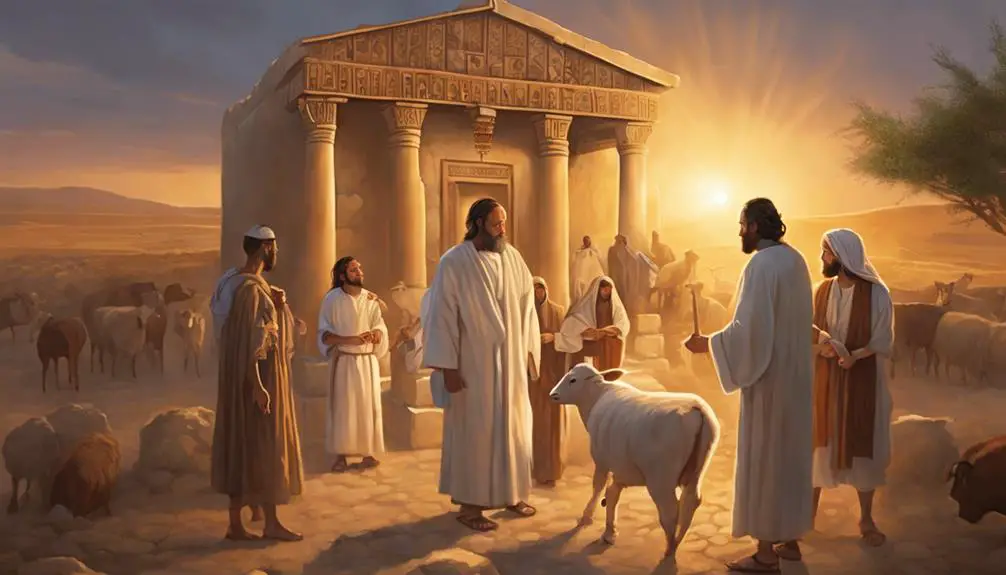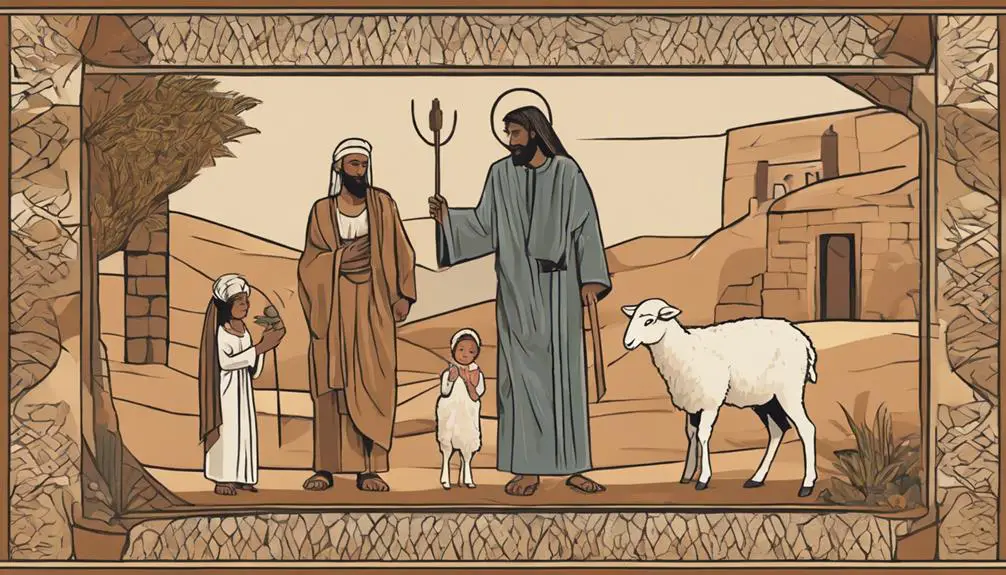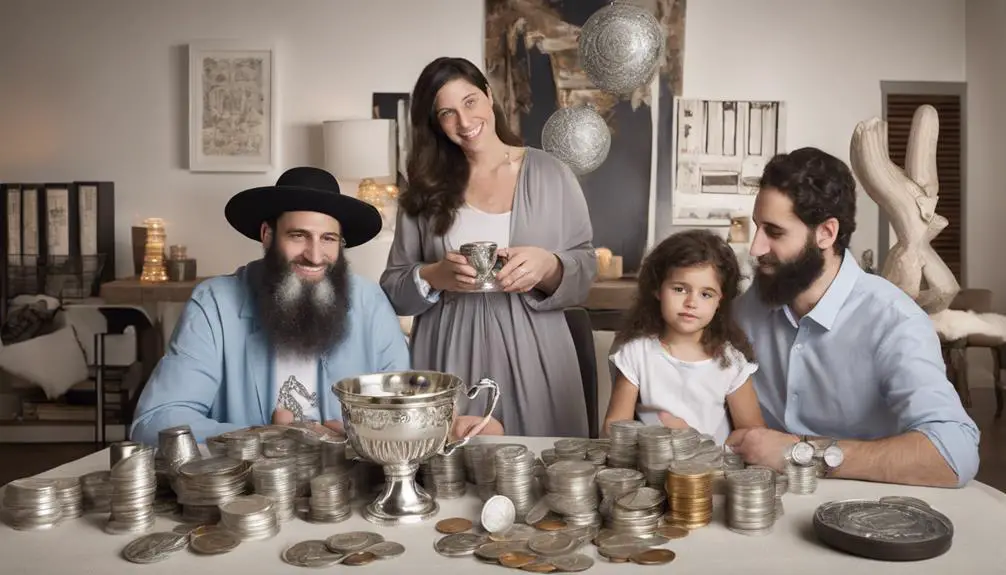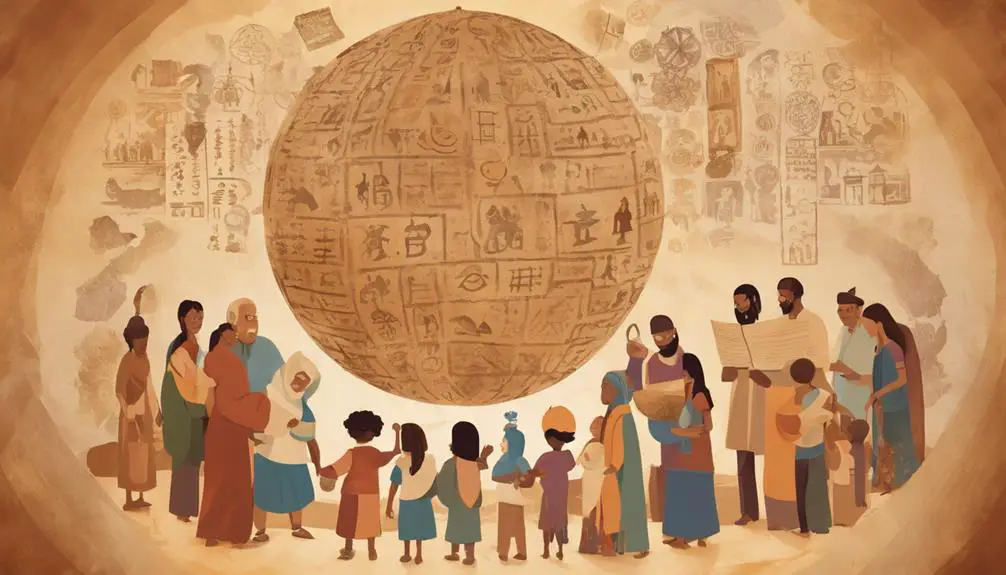Journey through the ancient rite of the firstborn's redemption in the Bible, unveiling its deep symbolism and lasting impact on culture today.

Redemption of the Firstborn in the Bible
When you explore the passages of ancient scriptures, you'll discover that 'transferring responsibility' refers to the fascinating rite of the redemption of the firstborn.
This practice, deeply rooted in history and tradition, involves a series of rituals and carries a wealth of symbolic meanings that have evolved over time.
You might wonder how such an ancient custom finds relevance in today's world or impacts modern practices and cultures. As you peel back the layers, you'll find that the answers to these questions reveal the enduring power of tradition and the intricate ways in which ancient beliefs continue to shape contemporary life.
Key Takeaways
- The redemption of the firstborn is rooted in ancient Near Eastern rituals and legal traditions.
- It symbolizes divine ownership and the sacrificial protection of the firstborn through specific ritual practices.
- Modern adaptations of the ritual maintain core elements while embracing educational and interfaith inclusivity.
- The practice has significant cultural, social, and economic impacts, reinforcing communal bonds and religious adherence.
Historical Origins

Tracing back to ancient Near Eastern traditions, the practice of redeeming the firstborn has deep historical roots that reflect its significance in early societal and religious contexts. You'll find that ancient parallels are abundant, underscoring how widespread this concept was across various civilizations. These parallels aren't mere coincidences; they're indicative of a shared cultural ethos that valued the firstborn for their potential leadership and spiritual roles within the community.
Diving deeper, you'll discover the legal implications that accompanied this practice. It wasn't just a ceremonial gesture but was embedded within the legal frameworks of these societies. This legal aspect ensured the practice's continuity and adherence, integrating it into the fabric of daily life. It's fascinating to see how these ancient legal systems recognized the firstborn's unique status, imposing specific obligations and privileges upon them.
This exploration into the historical origins reveals the layered complexity of redeeming the firstborn. It wasn't merely a ritual but a practice steeped in legal, societal, and religious significance. The ancient parallels provide a broader context, while the legal implications highlight the structured approach these societies took to preserve this tradition.
Ritual Procedures

Delving into the ritual procedures, you'll find that each step in the redemption process was meticulously designed to honor the firstborn's elevated status within both family and religious structures. This intricate process incorporated a series of acts, each with deep-rooted significance, including the use of animal substitutes and ceremonial cleansings. These elements weren't merely symbolic; they were foundational to the practice, ensuring purity and compliance with religious mandates.
- Selection of Animal Substitutes: Specific animals, deemed pure and acceptable, were chosen to symbolize the redemption of the firstborn. This act underscored the sanctity of life and the value placed on the firstborn's role.
- Ceremonial Cleansings: Prior to the redemption ceremony, there were prescribed washings and purifications. These cleansings served to prepare both the firstborn and the participants, symbolizing a renewal and a return to a state of spiritual purity.
- Recitation of Vows: The ceremony included specific prayers and vows, articulating the family's commitment to adhere to religious laws and to honor the significance of the firstborn.
- Transfer of Value: A key component involved the transfer of valuables, typically silver, to a religious figure. This act symbolized the redemption, effectively releasing the firstborn from the service obligation originally intended for him.
Each step was imbued with meaning, reflecting a deep appreciation for tradition and a profound understanding of the firstborn's role within both the family and the faith community.
Symbolic Meanings

Having explored the ritual procedures, we now turn our attention to the symbolic meanings embedded within these practices, shedding light on their deeper significance within the cultural and religious framework. At the heart of these ceremonies are concepts of Divine Ownership and Sacrificial Significance, each carrying profound implications for the participants and the broader community.
Symbol |
Meaning |
|---|---|
Firstborn |
Embodies the idea of Divine Ownership; a reminder that all life is considered a gift from the divine. |
Redemption |
Acts as a manifestation of the sacrificial significance; symbolizing the substitution and protection of the firstborn through a sacrificial offering. |
Five Shekels |
Represents the material aspect of redemption, quantifying the value of divine grace in tangible terms. |
Priestly Role |
Highlights the mediation between the divine and the earthly, facilitating the transfer of divine blessings. |
Sacrificial Animals |
Serve as a symbolic substitute, bearing the weight of human obligation to divine commands. |
These symbols weave together a rich tapestry of meaning, underscoring the intertwined nature of divine commandments, human responsibility, and the perpetual acknowledgment of a higher power's sovereignty over life. Through these practices, followers are continually reminded of their place within a larger cosmic order, guided by the principles of sacrifice, redemption, and divine ownership.
Modern Practices

Transitioning to contemporary times, the practice of redeeming the firstborn continues to resonate within many communities, albeit with nuanced adaptations reflecting modern sensibilities and contexts. You'll find that while the core ritual remains, its execution has evolved, accommodating the diverse lifestyles and beliefs of today's global communities. This evolution is particularly evident in areas such as tax implications and interfaith adaptations, underscoring the dynamic nature of this age-old tradition.
- Tax implications: In some jurisdictions, the financial transaction involved in the redemption process may have tax considerations. You're advised to navigate these with care, consulting with a tax professional to ensure compliance with local laws.
- Interfaith adaptations: Families where parents come from different faith backgrounds often seek ways to honor this tradition while respecting both partners' beliefs. This has led to creative adaptations that preserve the ritual's essence without alienating non-practicing partners.
- Virtual ceremonies: With the rise of digital platforms, you can now participate in or observe the ceremony from anywhere in the world, broadening access to this tradition.
- Educational emphasis: There's a growing focus on using the ceremony as an opportunity for educating participants about its historical and cultural significance, deepening its impact beyond a mere formality.
These adaptations highlight how the redemption of the firstborn has maintained its relevance by embracing change, ensuring its continued significance in the modern era.
Cultural Impact

The cultural impact of the redemption of the firstborn extends beyond mere religious observance, influencing social norms and community dynamics across various societies. This age-old practice, deeply rooted in biblical traditions, carries significant economic implications and alters social dynamics in communities that adhere to this custom.
From an economic perspective, the redemption of the firstborn necessitates a financial transaction, the 'Pidyon Haben,' which can strain family resources but also reinforces the value of religious adherence over material wealth. This act symbolizes a sacrifice of monetary value for spiritual gain, showcasing a community's commitment to uphold ancient traditions despite modern economic pressures.
Socially, this ritual fosters a sense of belonging and identity among community members, setting the firstborn apart in a unique role that carries both honor and responsibility. It strengthens familial bonds and communal ties through shared religious practice and collective participation in the ceremony. Moreover, it underscores the importance of continuity and the transmission of cultural and religious values from one generation to the next, ensuring the perpetuation of a community's identity and heritage.
Thus, the redemption of the firstborn encapsulates a complex interplay between economic sacrifices and social cohesion, illustrating the profound impact religious practices can have on community life.
Frequently Asked Questions
How Does the Redemption of the Firstborn Differ Between Various Denominations Within Judaism and Christianity?
Exploring how different denominations within Judaism and Christianity handle the redemption of the firstborn reveals a fascinating tapestry of beliefs.
You'll find that historical origins play a significant role in shaping these traditions, leading to ritual variations across the spectrum.
For instance, Judaism maintains specific ceremonies, while Christianity's interpretation and observance can vary widely, reflecting its broader doctrinal diversity.
This divergence highlights the complex interplay between scripture, tradition, and modern practice.
Are There Any Documented Cases Where the Redemption of the Firstborn Ceremony Has Led to Legal Disputes or Controversies in Contemporary Times?
Imagine stepping into a courtroom where ancient traditions clash with modern laws. You're witnessing a rare spectacle: legal disputes over a ceremony deeply rooted in cultural heritage. Documented cases are scarce, but when they arise, they delve into legal precedents and cultural adaptations.
These controversies not only challenge the legal system but also prompt a reexamination of how age-old practices fit within contemporary society, offering a rich field for scholarly analysis.
Has the Concept of the Firstborn Redemption Been Adopted or Adapted in Any Non-Abrahamic Religions or Cultural Traditions Worldwide?
You might wonder if the concept of firstborn roles, including redemption or special rituals, has been seen in non-Abrahamic traditions worldwide. Indeed, cultural parallels exist.
Many societies value firstborns uniquely, incorporating rituals that echo themes of redemption or special status, though they may not directly reference Abrahamic practices. These traditions often reflect societal values on inheritance, leadership, and spiritual responsibilities, showcasing a fascinating cross-cultural appreciation for the role of the firstborn.
How Do Atheist or Secular Families With Jewish Heritage Approach the Tradition of Redeeming the Firstborn, if at All?
When you're navigating the landscape of tradition, you might find secular adaptations of the firstborn celebration intriguing. Atheist or secular families with Jewish roots often approach this milestone with a nod to cultural significance rather than religious obligation.
They might opt for gatherings that honor their heritage in a more universal manner, focusing on the value of family and community, thus weaving a rich tapestry of acknowledgment without the religious strings attached.
What Psychological or Emotional Impacts Does Participating in or Being the Subject of a Firstborn Redemption Ceremony Have on Individuals and Families, Based on Modern Psychological Research?
Participating in firstborn redemption ceremonies significantly impacts your psychological and emotional state. Modern research suggests these rituals enhance parental bonding and reinforce cultural identity. By engaging in such traditions, you're likely to experience a deeper connection with your family lineage and a strengthened sense of belonging.
This process can profoundly affect both individuals and families, fostering a unique bond and affirming shared values and heritage.
Conclusion
In conclusion, the redemption of the firstborn, woven into the fabric of ancient tradition, remains a poignant symbol of faith and continuity. It's a bridge spanning past and present, ensuring that the echoes of our ancestors' commitments resonate in the rituals we observe today.
Through its meticulous observance, we're reminded of the profound bond between generations, a golden thread that ties us to our heritage. Analyzing this rite reveals the depth of its cultural and religious significance, underlining its enduring relevance in a modern context.



Sign up